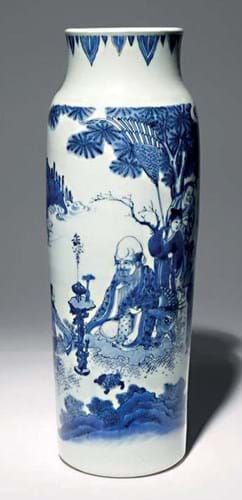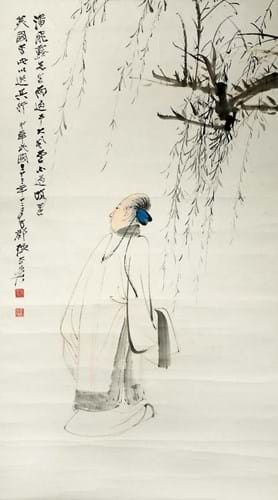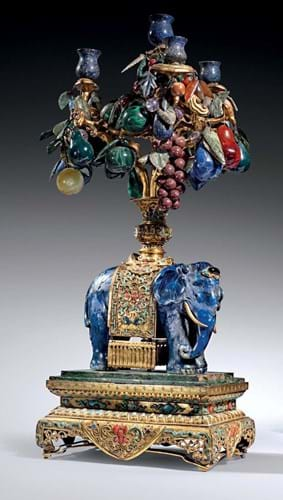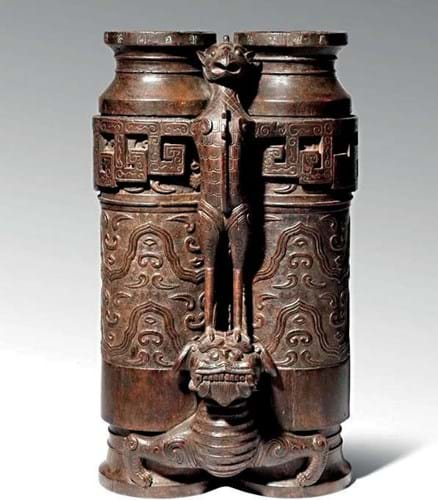In its place came new customers – the literati, the merchant class and foreign trading companies from Europe and Japan – and new wares catering to their tastes.
Among the most recognisable products of this era is the blue and white ‘sleeve’ vase: a tall cylindrical vessel freely decorated with extravagant landscapes or scenes from popular literature. Once the epitome of old European collecting taste, they are increasingly expensive.
Symbol of longevity
The sale of Chinese Paintings and Works of Art held by Woolley & Wallis (25% buyer’s premium) in Salisbury on July 1 included a fine example.
Standing a typical 18in (45cm) high, it was painted with Shoulao, the god of longevity, sitting with a deer as he watches a dance performance in a rocky mountain setting. An incense burner emits smoke which rises in the shape of a shou character – reinforcing the propitious blessings of long life.
The vase, from a British private collection, had been purchased for £15,000 at Christie’s in 2005 when it was dated c.1660. More probably the object was made in the final years of Chongzhen, the 17th and last emperor of the Ming who committed suicide as his capital city fell on April 25, 1644.
It was estimated this time at a very accessible £6000-8000 but took £46,000 (close to £60,000 with fees) from the European trade. This is among the strongest auction prices for a piece of this type, although punchy sums were seen for a group of sleeve vases offered by Sotheby’s in May 2018 as part of an Italian collection.
One of these, with an inscription dating it to the summer of yuiwei year (1643), took £62,000.
Three-catalogue selection
Rescheduled from May, the July 1-2 Asian series at Woolley & Wallis concluded with a hammer total of £1.9m. Three catalogues (including a sale of Japanese art and another of Asian art) numbered 730 lots, of which 75% were sold.
Post-lockdown, around 80 people had viewed in person. There were just 10 bidders in the room but most business was done by a bank of 15 phones. Around 90 bidders competed online for the Chinese works of art (a modest number that reflected the need to pay a deposit) with more than 200 contributing to the Japanese sale.
The auction house has enjoyed great success in recent years with post-war Chinese paintings.
This offering included an ink and colour on paper by Zhang Daqian (1899-1983) dated the 33rd year of the Republic (1944) sold at a low-estimate £50,000 to a Chinese buyer. It came with a provenance integral to the work itself: it was a gift from the artist to the diplomat James Kedzie Penfield (1908-2004) on his return to the US.
As referenced in the inscription (translated verso), Penfield had called twice at the artist’s studio to say goodbye but on both occasions Zhang Daqian had been out. Instead, as a means of saying farewell, Zhang Daqian painted this picture depicting himself as a scholar underneath a willow tree (a traditional gift of departure). The artist himself left China five years later with the founding of the People’s Republic.
Hallmarked jade
A white jade rectangular section snuff bottle carved to the neck with two lion masks holding rings in their mouths was incised to the base with the mark Xing You Heng Tang (Hall of Constancy) – the residence of the Manchu official Zhai Quan.
A great-grandson of the emperor Qianlong, he was a famous collector of works of art during the Daoguang and early Xianfeng periods before his death in 1854. A number of jades are known with this hallmark, including another snuff bottle sold at Bonhams Hong Kong as part of the Bloch collection in 2012 for around £16,000 and a waterpot at Sotheby’s Hong Kong in 2016 (£22,000).
This piece took a double-estimate £30,000 from a bidder in China.
A pair of late Qing lapis lazuli, polished hardstone and gilt bronze models of elephants led the sale at £68,000 (estimate £20,000-30,000) selling to a Chinese bidder. Similar to others illustrated in The Complete Collection of Treasures of the Palace Museum, Treasures of Imperial Court, they stand around 23in (57cm) high on elaborate pedestals decorated in coral, turquoise and other jewels.
These models were not in great condition but came with a Rothschild provenance. They are among a group of objects consigned for sale (across a number of different auctions) by the trustees of Exbury House, Hampshire, home of Lionel de Rothschild (1882-1942), and Edmund de Rothschild (1916-2009).
From the same source was an 18th century pear-shaped copper red ‘five dragon’ vase standing 22in (55cm) high. Once magnificent but now converted into a lamp (the base was lacking and the neck reduced), it nonetheless brought £26,000 (estimate £8000-12,000) from a Chinese buyer resident in UK.
Second slice
Leading the July 2 Part II sale was an aloeswood ‘champion vase’. The term refers to the rebus yingxiong or hero created by the mythical bird (ying) and bear (xiong) that populate these distinctive vessels.
Examples in jade and cloisonné are more common than those in aloeswood, the revered dark and resinous heartwood of the evergreen aquilaria tree.
The example here, catalogued as ‘Qing dynasty or later’ and in worn and chipped condition was relatively large at 18in (45cm) high and improved on a £1500-2500 guide to sell at £20,000.



















